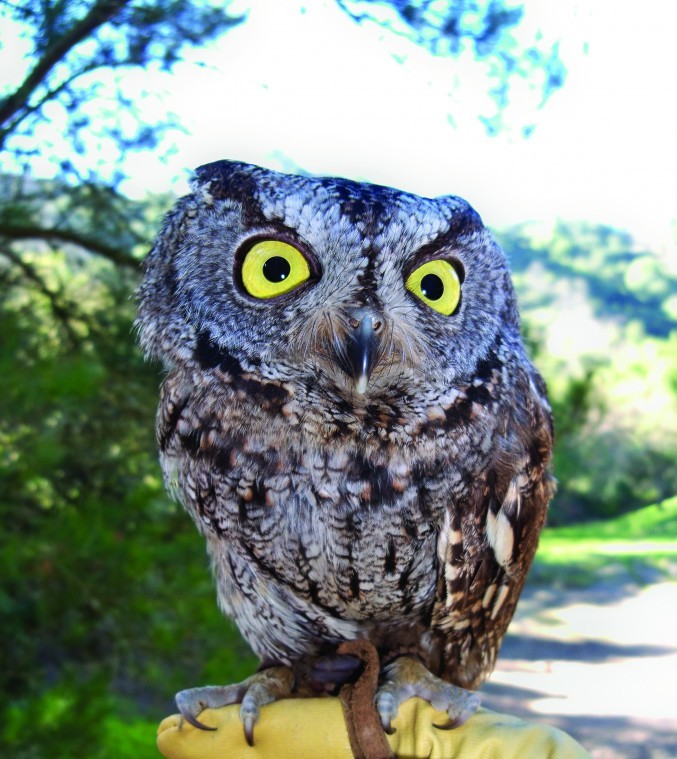Last year, the Wildlife Education and Rehabilitation Center’s Oscar, the screech owl who had been a popular educational animal at WERC since 1996, passed away on Easter Sunday. Several months later, WERC put out a notice to other wildlife rehabilitation centers that it was interested in acquiring another screech owl to join its educational animal ambassadors – non-releasable birds, mammals and reptiles that visit schools and public events to teach children and adults about our local native wildlife and habitats.
On Aug. 5, 2011, Tehama Wild Care, in Northern California, admitted a young western screech owl that had suffered an injured left wing due to vehicular collision near a busy road. The veterinarian’s examination showed that there were no breaks or dislocations and it was believed to be possibly a soft-tissue injury that would heal with time. But as time went by, the wing showed no improvement in mobility. Unfortunately, animals that have suffered permanent injuries or are imprinted cannot be released back to the wild – the loss of their sight, flight or “wildness” ensures that their chances for long-term survival would be negligible.
It was serendipity. The 6-inch female owl from Tehama was transferred to WERC on Aug. 29 for evaluation as an educational animal. Since she wasn’t able to fly, staff needed to make sure she was able to ambulate on her own. It was important that the owl be able to right herself if she toppled onto her back and to ensure that she doesn’t step onto and impale her bad wing with her talons. The owl was given a veterinary exam and certified that she was in great health and indeed suitable for education.
With permission granted by the U.S. Fish and Wildlife Service, Owlivia officially joined WERC’s educational animal team in December and is now a member of the OWL team – Owlivia, Wally the pygmy owl and Luna the great horned owl.
Unlike Oscar, Owlivia most likely won’t be able to hold a “second job” as a foster parent to orphaned screech owls. Due to her flight limitations, her enclosure is smaller and those growing owlets need much more room to fly.
***
The western screech owl, Megascops kennicottii (kennicotti in honor of Robert Kennicott, an American naturalist), does not screech. It’s unclear just why it’s been given that name. One theory is that other birds screech in fright when they see this feisty, aggressive, predatory raptor.
The screech owl’s voice is actually a sound that has been likened to an accelerating “bouncing ball” – a trilling series of six to eight low whistles, sometimes described as ghostly. The screech owl has been called little horned owl, mouse owl, mottled owl, dusk owl, ghost owl and little cat owl. (I have no idea how it got that last appellation, unless it had something to do with Edward Lear’s poem, “The Owl and the Pussycat”, who said of the owl, “how charmingly sweet you sing.” Lear’s illustration depicts the “elegant fowl” as a horned owl. But I digress.)
The screech owl is non-migratory and lives year-round in a wide variety of habitats including open woodlands (but not dense forests where great horned owls live and hunt), orchards, suburban parks and even residential areas. They nest in natural tree cavities, including those carved out by woodpeckers, but will readily inhabit man-made boxes.
An opportunist hunter, the screech owl eats mostly small rodents, but also includes insects, other birds, crayfish, reptiles and amphibians in its diet. It normally hunts by sitting and waiting for its “meal” to appear. Since the owl is nocturnal, hunting after dusk, it needs to hide from its own predators (Cooper’s hawks, larger owls, weasels, raccoons, skunks, squirrels, snakes and crows) during the daytime. And it has evolved a superb method of avoiding detection. When threatened or harassed, the owl stretches its body, tightens its feathers and extends its feather “horns” in order to look like a small branch. The screech owl has another example of natural camouflage – the colors and patterns of its feathers blend perfectly into the texture and tones of the tree bark.
***
Would you like to have Owlivia, and other of WERC’s educational animals, come and visit your child’s school? Go to www.werc-ca.org for details on WERC’s unique Silent Hunters, Birds of Prey and Feathers, Fur and Scales classroom programs, which offer students comprehensive lessons about our local wildlife and the opportunity to see native wildlife up close.










